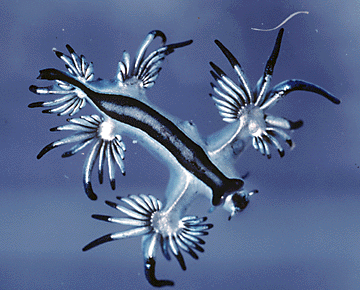Published in the Ocean Watch column, Honolulu Star-Advertiser © Susan Scott
March 29, 1999
AH, spring in Hawaii. Gusty trade winds knock down power lines, rain soaks our socks and temperatures plummet all the way down to the 60s.
Most people view this chickenskin weather as the perfect time to throw a blanket on the couch and open a good book. For me though, it’s time to hit the beach.
I don’t particularly like getting wet and cold but I just can’t pass up the possibilities. It’s during these periods of strong onshore winds that Hawaii’s beaches bear marine animals usually found only far offshore.
 A Glaucus atlanticus
A Glaucus atlanticus
Last week at Kailua Beach, after bundling up in sweats and braving some furious squalls, I was rewarded for my efforts. In one hour, I found four good specimens of one of my all-time favorite creatures — an offshore nudibranch (noo-dee-brank) called Glaucus atlanticus. This animal is out of this world in beauty, form and function.
Nudibranchs are snails without shells, like slugs, and because of this, they are often called sea slugs. Unlike land slugs, however, most nudibranchs are spectacularly beautiful. Many nudibranchs are brilliantly colored in red, yellow, orange, blue, green or a combination of colors.
For some nudibranchs, this flamboyant coloration works as good camouflage when crawling on coral, sponges, anemones or other marine animals. For others, the bright colors and patterns warn predators to stay away or suffer the consequences.
Since they don’t have shells to protect their soft bodies, nudibranchs have evolved interesting methods of self-protection. Some simply blend in and hide, but others eat animals bearing stinging cells or sponges bearing glasslike spikes.
These nudibranchs store the defensive material in their bodies. Then, when a predator strikes, it gets a painful jolt from recycled sponge spicules or from the stinging cells of a hydroid or anemone.
The Glaucus has a similar defense system. These bright blue-and-white nudibranchs float far offshore on the water’s surface by means of an air bubble in the stomach. There, they eat Portuguese man-of-wars, blue buttons, and other drifting jellyfish relatives.
Somehow, Glaucus can eat these creatures’ tentacles without discharging their stinging cells. The nudibranch stores these weapons in frilly projections of its body. When disturbed, the cells fire, thus stinging potential predators.
When winds blow hard onshore, the little nudibranchs (about 1 inch long) sometimes get beached. Look for a bright blue-and-white ball, about the size of a pea. When you place this rolled-up Glaucus in sea water, it opens like a flower with feathery blue petals.
I’ve never been stung by one of these beauties but it’s a possibility. If you find one, scoop it up with some sand, then drop it gently into a cup of water.
Last week at Kailua Beach, I got thoroughly salty, soggy and sandy. But I had nudibranchs!
I watched my four little gems float in their cup for a while, then released them in the ocean. After that, my couch, blanket and book felt better than ever.